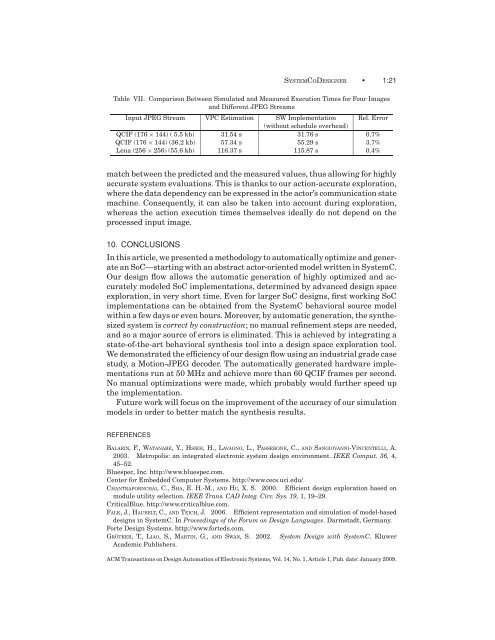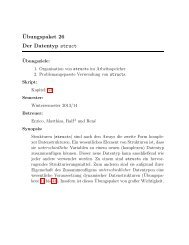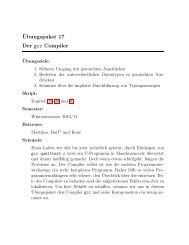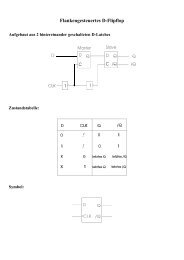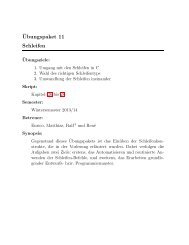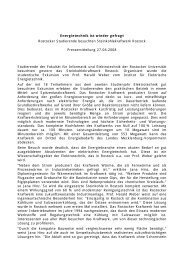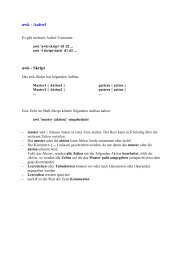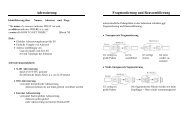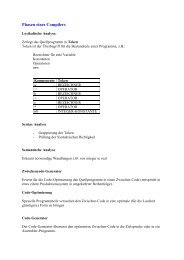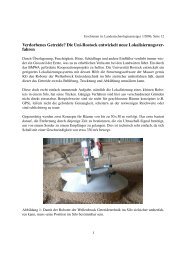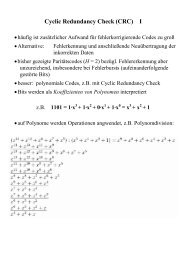An Automatic ESL Synthesis Approach by Design Space
An Automatic ESL Synthesis Approach by Design Space
An Automatic ESL Synthesis Approach by Design Space
You also want an ePaper? Increase the reach of your titles
YUMPU automatically turns print PDFs into web optimized ePapers that Google loves.
SYSTEMCODESIGNER • 1:21<br />
Table VII. Comparison Between Simulated and Measured Execution Times for Four Images<br />
and Different JPEG Streams<br />
Input JPEG Stream VPC Estimation SW Implementation Rel. Error<br />
(without schedule overhead)<br />
QCIF (176 × 144) ( 5.5 kb) 31.54 s 31.76 s 0.7%<br />
QCIF (176 × 144) (36.2 kb) 57.34 s 55.29 s 3.7%<br />
Lena (256 × 256) (55.6 kb) 116.37 s 115.87 s 0.4%<br />
match between the predicted and the measured values, thus allowing for highly<br />
accurate system evaluations. This is thanks to our action-accurate exploration,<br />
where the data dependency can be expressed in the actor’s communication state<br />
machine. Consequently, it can also be taken into account during exploration,<br />
whereas the action execution times themselves ideally do not depend on the<br />
processed input image.<br />
10. CONCLUSIONS<br />
In this article, we presented a methodology to automatically optimize and generate<br />
an SoC—starting with an abstract actor-oriented model written in SystemC.<br />
Our design flow allows the automatic generation of highly optimized and accurately<br />
modeled SoC implementations, determined <strong>by</strong> advanced design space<br />
exploration, in very short time. Even for larger SoC designs, first working SoC<br />
implementations can be obtained from the SystemC behavioral source model<br />
within a few days or even hours. Moreover, <strong>by</strong> automatic generation, the synthesized<br />
system is correct <strong>by</strong> construction; no manual refinement steps are needed,<br />
and so a major source of errors is eliminated. This is achieved <strong>by</strong> integrating a<br />
state-of-the-art behavioral synthesis tool into a design space exploration tool.<br />
We demonstrated the efficiency of our design flow using an industrial grade case<br />
study, a Motion-JPEG decoder. The automatically generated hardware implementations<br />
run at 50 MHz and achieve more than 60 QCIF frames per second.<br />
No manual optimizations were made, which probably would further speed up<br />
the implementation.<br />
Future work will focus on the improvement of the accuracy of our simulation<br />
models in order to better match the synthesis results.<br />
REFERENCES<br />
BALARIN, F., WATANABE, Y., HSIEH, H., LAVAGNO, L., PASSERONE, C., AND SANGIOVANNI-VINCENTELLI, A.<br />
2003. Metropolis: an integrated electronic system design environment. IEEE Comput. 36, 4,<br />
45–52.<br />
Bluespec, Inc. http://www.bluespec.com.<br />
Center for Embedded Computer Systems. http://www.cecs.uci.edu/.<br />
CHANTRAPORNCHAI, C., SHA, E. H.-M., AND HU, X. S. 2000. Efficient design exploration based on<br />
module utility selection. IEEE Trans. CAD Integ. Circ. Sys. 19, 1, 19–29.<br />
CriticalBlue. http://www.criticalblue.com.<br />
FALK, J., HAUBELT, C.,AND TEICH, J. 2006. Efficient representation and simulation of model-based<br />
designs in SystemC. In Proceedings of the Forum on <strong>Design</strong> Languages. Darmstadt, Germany.<br />
Forte <strong>Design</strong> Systems. http://www.forteds.com.<br />
GRÖTKER, T., LIAO, S., MARTIN, G., AND SWAN, S. 2002. System <strong>Design</strong> with SystemC. Kluwer<br />
Academic Publishers.<br />
ACM Transactions on <strong>Design</strong> Automation of Electronic Systems, Vol. 14, No. 1, Article 1, Pub. date: January 2009.


